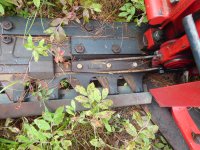I'm re-sectioning and replacing the double guards on my 7' HN451 after 5+ years. I've always just used a rounding hammer, I think it's about a 2 pounder. One side is rounded, the other is flat. I use the flat end. I also happen to have a 225 lb horseshoer's anvil so I have something to work against. Since I'm replacing all my secctions, I bought a 7/8x4" grade 8 bolt that I'm going to stick in the anvil, it's got a square hole for tools and the 7/8 fits nicely. I'll drill a indent in the bolt head to accept the rivet head. Personally I've never had any experience with the bolts, but I couldn't expect they would last as good as a good rivet job. I don't worry about the top, it flattens out nicely with the 2 lb hammer and fills the hole, making the section really tight. I'm also going to try to use another smaller bolt with a similar dimple in it for the top, but I'm not holding my breath if it doesn't work very good. My trouble is getting the rivets out where there's a double bar on both sides of the section, near the drive side. I'll have to drill them out, they don't seem to want to punch out.
Even just a railroad plate would be good enough to work against. However hammering between those raised areas would require one of those tools, I've never used one.
Oh, I see this is from last year.
